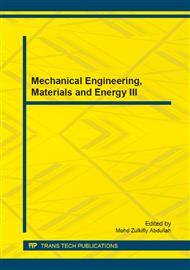[1]
Sukhanov, V. B., General System of Symmetrical Locomotion of Terrestrial Vertebrates and Some Features of Movement of Lower Tetrapods, Academy of Sciences, USSR, (1968).
Google Scholar
[2]
Newcastle, P. G., La methode et l'evention nouvelle de dresser les chevaux, Anvers., Cited by Muybridge, (1957).
Google Scholar
[3]
Alexander, R. M. and A. S. Jay, Estimates of Energy Cost for Quadrupedal Running Gaits, J. of Zoology, 1980, pp.153-170.
Google Scholar
[4]
McGhee, R. D. and G. I. Iswandhi, Adaptive Locomotion of a Multilegged Robot over Rough Terrain, IEEE Trans. on Systems, Man, and Cybernetics, Vol. SMC-9, No. 4, 1979, pp.176-182.
DOI: 10.1109/tsmc.1979.4310180
Google Scholar
[5]
Song, S. M. S., Kinematic Optimal Design of a Six-Legged Walking Machine. Ph.D. Dissertation, Ohio State University, Columbus, Ohio, (1984).
Google Scholar
[6]
Koo, T. W. and Y. S. Yoon, Dynamic Instant Gait Stability Measure for Quadruped Walking Robot, Robotica, Vol. 17, 1999, pp.59-70.
DOI: 10.1017/s0263574799001058
Google Scholar
[7]
Yoneda, K. and S. Hirose, Dynamic and Static Fusion Gait of a Quadruped Walking Vehicle on a Winding Path, Advanced Robotics, 9(2), 1995, pp.125-136.
DOI: 10.1163/156855395x00030
Google Scholar
[8]
Lin, B. S. and S. M. Song, Dynamic Modeling, Stability and Energy Efficiency of a Quadrupedal Walking Machine, IEEE Int. Conf. on Robotics and Automation, 1993, pp.367-373.
DOI: 10.1109/robot.1993.292201
Google Scholar
[9]
Zhang, C. D. and S. M. Song, Stability Analysis of Wave Crab Gaits of a Quadruped, J. of Robotic Systems, Vol. 7(2), 1990, pp.243-276.
DOI: 10.1002/rob.4620070208
Google Scholar
[10]
Park, S. H. and Chung, G. J., Quasi-Static Obstacle Crossing of an Animal Type Four-Legged Walking Machine, Robotica, Vol. 18, 2000, pp.519-533.
DOI: 10.1017/s0263574799002593
Google Scholar
[11]
Durr, V., Schmitz, J. and Cruse, H., Behavior-based modeling of hexapod locomotion: linking biology and technical application, Arthropod Structure & Development, pp.237-250, 33, (2004).
DOI: 10.1016/j.asd.2004.05.004
Google Scholar
[12]
Webb, B. and Consi, T., Biorobotics: methods and applications, MIT Press, (2001).
Google Scholar
[13]
Fisher, M. S., Walking, Climbing and Reaching: News on Kinematics and Dynamics and Questions about the Level of Control, 4'th Int'l Sym. on Adaptive Motion of Animals and Machines, CWRU, Cleveland, Ohio, June 1-6, (2008).
Google Scholar
[14]
Ogihara, N., Aoi, S., Sugimoto, Y., Nakatsukasa, M. and Tsuchiya, K., Synthetic study of quadrupedal/bipedal locomotion in the Japanese monkey, 4'th Int'l Sym. on Adaptive Motion of Animals and Machines, CWRU, Cleveland, Ohio, June 1-6, (2008).
Google Scholar
[15]
Hackert, R., Witte, H. and Fisher M. S., Interaction between motions of the trunk and the limbs and the angle of attack during synchronous gaits of the pika, 4'th Int'l Sym. on Adaptive Motion of Animals and Machines, Montreal, Aug. 8-12, (2000).
DOI: 10.1007/4-431-31381-8_7
Google Scholar
[16]
Uspenskii, V. D., Anatomical-Physiological Analysis of Limb in Allure and Its Practical Significance, Tr. Statovsk Zoovet. Inst., Vol. 4, pp.109-115, (1953).
Google Scholar
[17]
Gabrille, G. and Von Karman, T. H., What price Speed, Mechanical Engineering, Vol. 72, No. 10, pp.775-781, (1950).
Google Scholar
[18]
Park, S. H. and Hong, D. P., Locomotive Characteristics of Body and Limb in a Terrestrial Vertebrates, Applied Mechanics and Materials, Vol. 249-250, pp.180-188, (2013).
DOI: 10.4028/www.scientific.net/amm.249-250.180
Google Scholar


